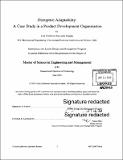Disruptive adaptability : a case study in a product development organization
Author(s)
Saavedra Román, Jóse Guillermo
DownloadFull printable version (13.05Mb)
Other Contributors
Massachusetts Institute of Technology. Engineering Systems Division.
Advisor
Patrick Hale.
Terms of use
Metadata
Show full item recordAbstract
Enhancing the practice of Product Development has been addressed in multiple works and published in documents of all kind ranging from theses and consultancy studies to papers in specialized journals. Regardless of the focus, either on processes, tools, methods or organizational design what is common is a reactive -"gapflling"-approach. In this work I propose that enhancing the practice of product development is better achieved when it is addressed from a holistic perspective in which either the improvement, optimization or enhancement of the product development practice is in essence an adaptation of the product development organization. Seeing the practice of product development from the adaptability lens, allows us to create enhancements that go beyond the traditional "gap-filling" approach of fixing issues using information from the past, and opens up a broader -yet richer-set of alternatives to design improvements that not only prevent issues to occur but that also are meant to change the game. The main focus of this work is the design of a disruptive adaptation for Ford Motor Company Product Development Organization focused on its capabilities for the development of in-vehicle features which are instrumental in the customer experience that is delivered by Ford automobiles. This design was developed following a systems thinking approach for large complex systems and is aligned to Ford Motor Company objective of changing the way the world moves. The design concept for this disruptive adaptation focuses on elaborating a desired future state of the capabilities to develop an unparalleled customer experience in Ford vehicles. It also considers the future context of a platform-based business model where the automobile is the platform. As starting point, I researched the current state of Ford capabilities for the development of in-vehicle features and realized that the Electronic Control Units (ECUs) of the vehicle play a fundamental role. Then, I used systems modeling tools such as Domain Mapping Matrix (DMM) and Design Structure Matrix (DSM) to understand and quantify the patterns of interaction among vehicle features that occur across all Electronic Component Units (ECUs) of an automobile. Finally I developed a holistic proposal to adapt the strategy, methods, tools and organizational structure that is meant to support Ford Motor Company in its pursuit to disrupt the mobility paradigm.
Description
Thesis: S.M. in Engineering and Management, Massachusetts Institute of Technology, School of Engineering, System Design and Management Program, Engineering and Management Program, 2016. Cataloged from PDF version of thesis. Includes bibliographical references (pages 94-100).
Date issued
2016Department
Massachusetts Institute of Technology. Engineering and Management Program; System Design and Management Program.Publisher
Massachusetts Institute of Technology
Keywords
Engineering and Management Program., System Design and Management Program., Engineering Systems Division.